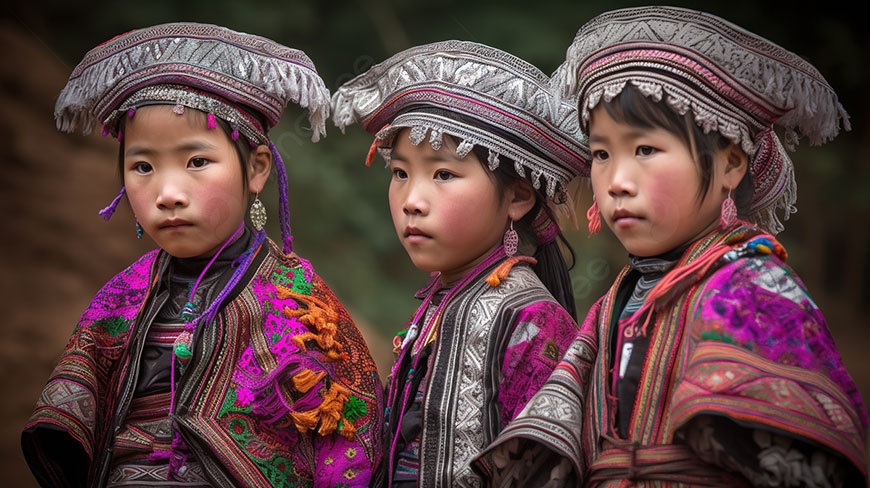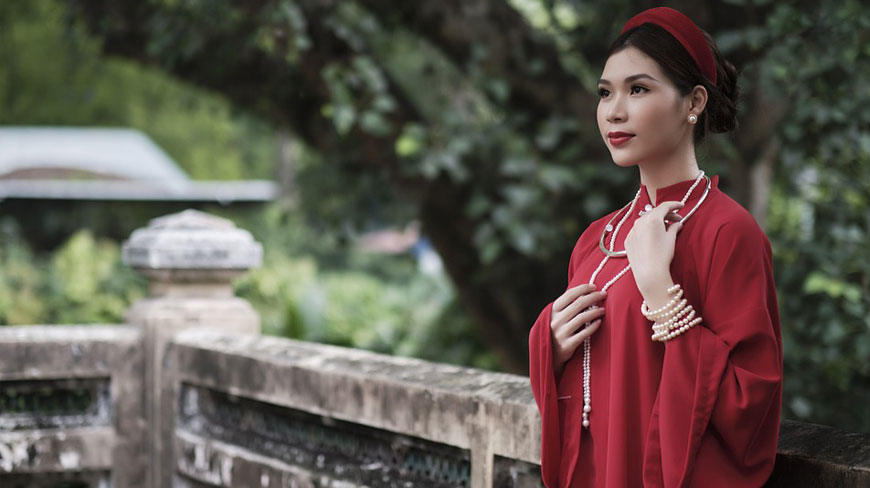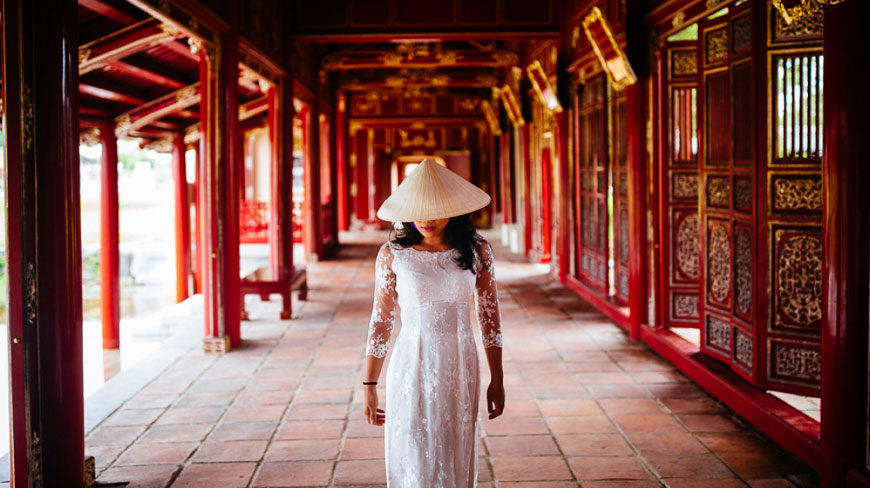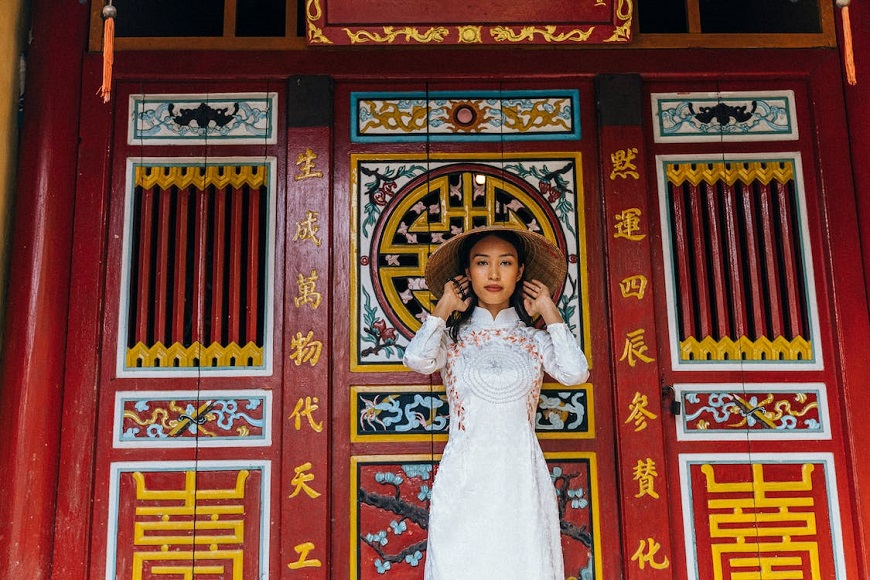Renowned for its rich cultural heritage, Vietnam can be proud of its traditional costumes. Gradually regaining their place in modern society, they are not limited to the famous Ao Dai.

Ha Nu Ethnic children of Vietnam in traditional costume - Picture : pngtree
Traditional Vietnamese costumes, an introduction
Is it necessary to specify that clothes are part of the cultural heritage of a nation? With the incredible richness of its ethnic mosaic, Vietnam can boast an exceptional wardrobe!
54 ethnic groups and as many traditional costumes, with different cuts, patterns and ports, sharing however richly worked ornaments and shimmering colors.
For the Kinh, the majority ethnic group, it’s another story. Under the Nguyen dynasty, for example, restrictions were imposed on the type and colors of clothing worn: for men, the brown clothing combo with turbans and wooden shoes or sandals was mandatory. The authorized colors were limited to brown, black and white; yellow was the royal color and red was worn only by high ranking mandarins. As for blue and green, these colors were found in the decorative elements of the lower rank mandarins costumes. The women wore shirts in light brown tones and a black jacket, complementing their outfit with the essential conical hat.
The traditional style of clothing worn in Vietnam, known as Viet phoc, reflects both local elements and foreign influences encountered during the history of the S-shapped country.
Examples of traditional Vietnamese costumes include ao Tac, ao Giao Linh, ao Nhat Binh, and ao Ngu Than, among others. Characterized by natural materials such as hemp, silk or cotton, these garments are thin, ample and light, perfectly adapted to the tropical climate of the country to the longlines.
To conclude this quick presentation of the different traditional clothing in Vietnam, note that some of them were lost, replaced by more modern interpretations. It is also worth noting a clear renewed interest on the part of young people for traditional clothing, gladly worn for photos taken in the streets of the old quarter, or around Hoan Kiem Lake (restored Sword Lake) and even more for important ceremonies, like the graduation ceremony. Many websites have flourished on the web, created by fashion culture enthusiasts.

Woman wearing Ao Tac - Picture : pixabay
Some traditional Vietnamese costumes
Ao Tac
Ao Tac is the costume worn under the Nguyen dynasty. The origin of the name ao Tac comes from the width of the hem of the shirt, which measures exactly one inch (about 4 cm). It refers to a shirt with five sides and wide sleeves, worn by both women and men, whatever the class. This will be marked by the materials used (silk, brocade or other), colors, patterns and accessories. Sometimes called Ceremonial Shirt, the ao Tac was worn mainly during important ceremonies such as a wedding, funeral or during the festivities of the Lunar New Year.
Ao Giao Linh
It is the oldest form of clothing in East Asia. This type of clothing is close to the traditional costumes of China and is characterized by a cross collar on the chest, with a left flap that is superimposed on the right flap. The sleeves can be wide or narrow. The most obvious difference with the suit worn in the Middle Kingdom is seen in the inner and outer hems, which are not equal.
Ao Nhat Binh
Costume of the royal family, it is worn both by the queen, the concubine and the princess. Its collar is called "Nhat Binh" because of its pattern which, when assembled, forms a rectangle right in front of the chest. After the period of the Nguyen dynasty, this outfit will be the costume worn by the nobility on special occasions.
Ao Ngu Than
This five-sides ao Dai was born in 1744 following the costume reform launched by Emperor Nguyen Phuc Khoat. This type of outfit has a high, straight and square collar symbolizing the integrity of a gentleman. There are 5 buttons in metal, jade, wood, etc., and not in fabric like the Chinese cheongsam, symbols of the four parents, and of a child (the one who wears the clothe). The skirt is loose and flares down, with a curved edge. If ao Ngu Than has experienced many changes over time, it has never made a distinction between class, sex or age.

Woman in traditional Ao Dai - Picture : Internet
Ao Dai
Traditional Vietnamese costume par excellence and aimed at both men and women, ao Dai is presented in its male version as a long silk tunic falling to the knees, with a conventional fitted collar, buttoned on the left side. It is usually worn over loose trousers.
As quickly mentioned above, the color of the ao Dai indicated the position of a man in society. Gold represented royalty, the royal ao Dai being adorned with dragons-shapped embroidery, symbols of strength and power. High-ranking officials wore purple ao dai and commoners appeared in different shades of blue.
If nowadays, Ao Dai is not commonly worn on a daily basis by gentlemen, it remains a symbol of elegance that will be seen especially at weddings and Tet ceremonies.
The female version of the ao Dai is similar to its male counterpart, but falls to the ankles. There are two main variants – one with four-sided flaps at the front that button and the other in five parts, with an additional flap on the right, to prevent possible embarrassing wardrobe malfunction.
It should be noted here that the ao Dai is different depending on whether you live in the North or the South of the two Deltas Country. In the North, the four-sided ao Dai is worn with a long skirt and a leafy hat, called Thao Non-Quai, or sometimes, just a scarf on the head. In the southern part of Vietnam, it is worn on loose pants, white, black or even colored. Called ao Ba Ba, this version worn in the Mekong Delta is characterized by a shirt without collar, on the back made of a straight piece of fabric. The front body consists of two pieces and in the middle there are two straps that run from top to bottom.

Woman with conical hat - Picture : pexels
No La: the traditional hat
Omnipresent and indispensable, the famous conical hat belongs to the clothing heritage of Dragon Land!
The name comes from that these hats are made from palm leaves. Born in Hue, the Non La protects from the sun and rain, is worn as a fashion statement or becomes the mandatory accessory to write poetry.
Vietnam’s traditional costumes, a few words to conclude
Not so long ago, when we thought of ancient costumes, we thought of Hanfu from China, Kimono from Japan or Hanbok from Korea. It will now be necessary to count with the eternal ao Dai of Vietnam and its place in modern life, as a unique and strong link between past and present.